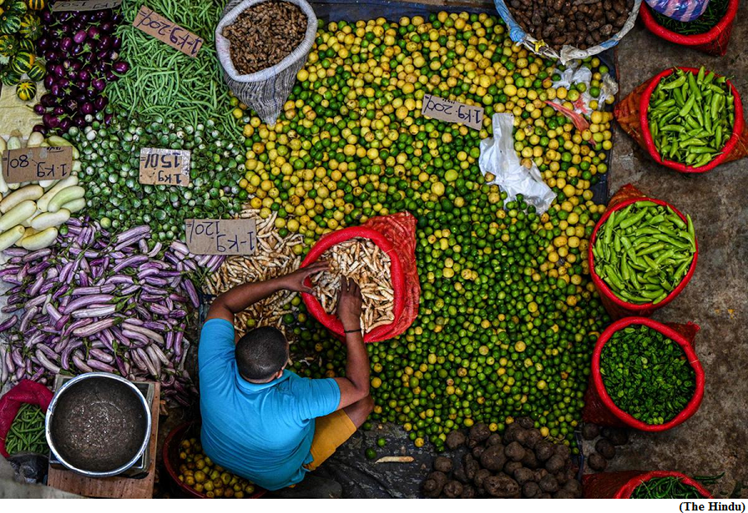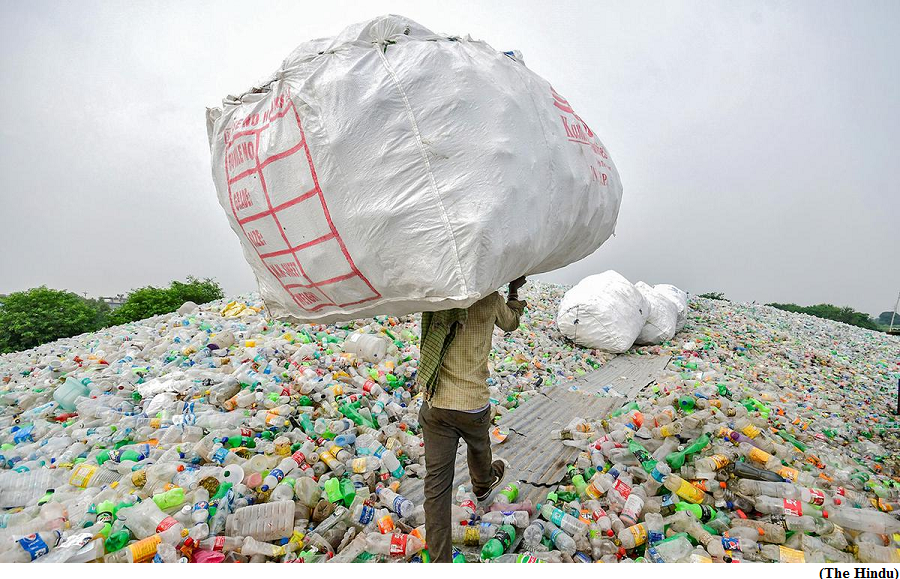Understanding IMF bailouts (GS Paper 3, Economy)

Why in news?
- The International Monetary Fund (IMF) recently confirmed a $3 billion bailout plan for Sri Lanka’s struggling economy.
- IMF officials are also in negotiations with Pakistan for a $1.1 billion bailout plan as the country faces a severe economic crisis marked by a falling currency and price rise.
Why do nations seek an IMF bailout?
- Countries seek help from the IMF usually when their economies face a major macroeconomic risk, mostly in the form of a currency crisis.
- For instance in the case of Sri Lanka and Pakistan, both countries have witnessed domestic prices rise rapidly and the exchange value of their currencies drop steeply against the U.S. dollar. Such currency crises are generally the result of gross mismanagement of the nation’s currency by its central bank, often under the covert influence of the ruling government.
- Central banks may be forced by governments to create fresh money out of thin air to fund populist spending. Such spending eventually results in a rapid rise of the overall money supply, which in turn causes prices to rise across the economy and the exchange value of the currency to drop.
- Meanwhile, a country’s domestic economic policies can also have an adverse impact on its currency’s exchange rate and foreign exchange reserves.
- In the case of Sri Lanka, a decrease in foreign tourists visiting the country led to a steep fall in the flow of U.S. dollars into the nation.
How does the IMF help countries?
- The IMF basically lends money, often in the form of special drawing rights (SDRs), to troubled economies that seek the lender’s assistance. SDRs simply represent a basket of five currencies, namely the U.S. dollar, the euro, the Chinese yuan, the Japanese yen, and the British pound.
- The IMF carries out its lending to troubled economies through a number of lending programs such as the extended credit facility, the flexible credit line, the stand-by agreement, etc. Countries receiving the bailout can use the SDRs for various purposes depending on their individual circumstances.
- Currently, both Sri Lanka and Pakistan are in urgent need for U.S. dollars to import essential items and also to pay their foreign debt. So any money that they receive from the IMF is likely to go towards addressing these urgent issues.
- The IMF was set up in 1945 out of the Bretton Woods conference. The primary goal of the IMF back then was to bring about international economic coordination to prevent competing currency devaluation by countries trying to promote their own exports.
- Eventually, the IMF evolved to be a lender of last resort to governments of countries that had to deal with severe currency crises.
Are there any strings attached to an IMF bailout?
- The IMF usually imposes conditions on countries before it lends any money to them. For example, a country may have to agree to implement certain structural reforms as a condition to receive IMF loans.
- The IMF’s conditional lending has been controversial as many believe that these reforms are too tough on the public. Some have also accused the IMF’s lending decisions, which are taken by officials appointed by the governments of various countries, to be influenced by international politics.
- Supporters of the IMF’s lending policies, however, have argued that conditions are essential for the success of IMF lending. For one, countries that seek an IMF bailout are usually in a crisis due to certain policies adopted by their governments that turned out to be inimical to economic growth and stability.
- The IMF lending to troubled economies, may turn out to be a wasted effort because these economies have poor institutions and suffer from high corruption. In other words, these countries are most likely to squander the bailout money.
Why has the T.N. government decided to merge schools?
(GS Paper 2, Governance)
Why in news?

What are these schools?
- The budget announcement indicated that the schools run by the Adi Dravidar and Tribal Welfare (ADTW), Backward Classes, Most Backward Classes, and Denotified Communities Welfare (BCW), Welfare of the Differently-abled Persons (WPD), Forest, and Hindu Religious and Charitable Endowments (HR&CE) departments will be merged.
- These departments run 1,834 schools with roughly 1.6 lakh students on their rolls. The ADTW department alone accounts for 80% of these schools (1,466) and students (1.26 lakh).
- Within the ADTW department, there are 1,138 Adi Dravidar Welfare schools. The remaining 328 are Government Tribal Residential (GTR) and Eklavya Model Residential Schools, run mainly for Scheduled Tribes (ST).
- The BCW runs 295 schools, HR&CE runs 32, WPD 22, and the forest department 19. These schools, especially those run by ADTW and BCW departments, were created to focus on education for marginalised sections.
- For instance, the Adi Dravidar schools have their origins in the British Raj. They were created with the support of the labour department for the “Depressed Classes (as the Scheduled Castes were then referred),” who were denied education elsewhere. They were then moved to the Social Welfare department and later to ADTW, when it was created.
- Similarly, the BCW runs the Kallar reclamation schools, which have their origins before Independence. They were created, mainly for the PiramalaiKallar community, who faced marginalisation due to the draconian Criminal Tribes Act brought by the British.
Why are they being merged?
- The schools will be merged to “achieve the goal of social justice,” “improve the quality of schools” and to ensure “quality education for all”. The relatively poor quality of these schools, especially those run by ADTW and BCW departments, have long been a concern. Their infrastructure is below par and a lot of teaching posts are vacant.
- Another key reason, although not officially acknowledged in the budget, was the caste identifier in the names of the schools run by ADTW and BCW departments. In Tamil Nadu, Adi Dravidar refers to the SCs. Similarly, the names Kallar Reclamation and GTR refer to specific communities.
- The argument by a section is that the caste identifiers, especially in case of Adi Dravidar welfare schools, result in the students feeling isolated and prevent those from other communities joining these schools in more numbers.
- While there was a need in the past for such schools as these communities did not have access to education elsewhere, they argue that with the situation being improved, these schools were now resulting in “ghettoisation”.
What are the concerns?
- While there seems to be a broad agreement that the poor quality of these schools need to be addressed, there is concern over the merger being projected as the magic bullet.
- The discussion has focused on the ADTW department for many factors, including its higher share of schools, higher budget, and historic and political context. Many have highlighted that the schools were in poor shape due to prolonged negligence and widespread irregularities.
- Merging the schools without addressing these issues would only result in them being denied the special focus they deserve by the SE department which is huge.
- With successive T.N. governments already blamed for reduced spending under the SC and Tribal Sub Plans, there is concern that the merger will result in further diversion of funds. Importantly, many are surprised that such an announcement has been made without consultations with the stakeholders concerned.
What is biotransformation technology and how can it reduce packaging waste?
(GS Paper 3, Environment)
Why in news?
- A U.K.-based startup, based at Imperial College in London, claims to have developed a technology that could alter the state of plastics and make them biodegradable. The company calls the process “biotransformation”.
- It claims the technology would digest the plastic packaging waste naturally with the help of microbes and biodegrade the waste without leaving behind any microplastics.

Burden of plastic waste:
- E-commerce giant Amazon generated an estimated 321 million kilograms (709 million pounds) of plastic from packaging waste in 2021 alone. This is a result of billions of boxes it shipped to its customers globally, according to a December 2022 report by Oceana.
- This is enough plastic to circle the Earth over 800 times as air pillows. While Amazon refuted Oceana’s claim, stating that it follows a science-based approach to reduce packaging waste, there is a lot left to be done.
What is biotransformation technology?
- Biotransformation technology is a novel approach to ensure plastics that escape refuse streams are processed efficiently and broken down. The tech was co-developed by the Imperial College in London, U.K., and a Britain-based startup, Polymateria.
- Plastics made using this technology are given a pre-programmed time during which the manufactured material looks and feels like conventional plastics without compromising on quality.
- Once the product expires and is exposed to the external environment, it self-destructs and biotransforms into bioavailable wax. This wax is then consumed by microorganisms, converting waste into water, CO2, and biomass.
Application in India:
- India’s Environment Minister in 2022 said that the country is generating 3.5 billion kgs of plastic waste annually and that the per capita plastic waste generation has doubled in the past five years. Of this, a third comes from packaging waste.
- In 2019, plastic packaging waste from e-commerce firms was estimated at over a billion kilograms worldwide.
- A joint research project by the Department of Management Studies, IIT Delhi, and Sea Movement noted that Amazon generated, nearly 210 million kgs (465 million pounds) of plastic from packaging waste in 2019. They also estimated that up to 10 million kgs (22.44 million pounds) of Amazon’s plastic packaging ended up in the world’s freshwater and marine ecosystems as pollution in the same year.
- However, Amazon India has now eliminated single-use plastics across its fulfilment centers. Flipkart has also done the same in 2021 across its supply chain.
Where can this technology be used?
- Food packaging and health care industries are the two prime sectors that could use this technology to reduce waste.
- Some well-known Indian firms in food and packaging industries deploy such technologies. Within healthcare and pharma industries, this technology provides biodegradable solutions for non-woven hygiene products like diapers, sanitary napkins, facial pads, etc.
Initiatives in India:
- The Indian government has launched multiple initiatives to move the country towards sustainability. They have introduced a plastic waste management gazette to help tackle the ever-growing plastic pollution caused by single-use plastics. Additionally, last year, the government imposed a ban on single-use plastics to bring a stop to its use in the country.
- The National Dashboard on Elimination of Single Use Plastic and Plastic Waste Management brings all stakeholders together to track the progress made in eliminating single-use plastic and effectively managing such waste.
- An Extended Producer Responsibility (EPR) portal helps in improving accountability traceability, and facilitating ease of compliance reporting in relation to EPR obligations of the producers, importers and brand-owners.
- India has also developed a mobile app to report single use plastics grievances to check sale, usage or manufacturing of single use plastics in their area.
What are the alternatives to reducing plastic waste?
- A switch to jute or paper-based packaging could potentially cut down plastic waste. This could also build sustainability within the paper industry, and save on the import bill on ethylene solutions.
- The wooden packaging is yet another alternative, but that will make the packaging bulkier and increase cost.
- The Government of Tamil Nadu, in Chennai, organised a National Expo and Conference of Startups to raise awareness on alternatives to single-use plastics. The alternatives showcased were made using coir, bagasse, rice and wheat bran, plant and agricultural residue, banana and areca leaves, jute and cloth.




